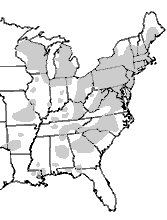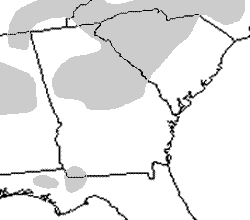Four-toed Salamander (Hemidactylium scutatum)



Photos by J.D. Willson unless otherwise noted
Description: Length ranges from 2-4 inches (5.1-10.2 cm). Coloration is reddish brown or brown above with silver flecking on the sides. The belly is porcelain white with small, but bold, black spots scattered randomly about the venter. There are four toes on the front and hind feet, and it is the only terrestrial salamander with four toes on each foot. There is an obvious constriction at the base of the tail where it can detach if grabbed by a predator, and it can be regenerated. There are indented lines on top of the head two of these forming a wide Y. These grooves continue down the back. When viewed from above, these grooves look like chevrons. Costal grooves, 13-14.
Range and Habitat: Although found throughout the eastern United States, four-toed salamanders are patchily distributed and are absent from many areas of apparently suitable habitat. Within our region this species is almost completely restricted to the Piedmont and lower elevations of the mountains. Found under logs and rocks in bogs, boggy streams, and floodplains; almost always in association with sphagnum moss.
Habits: Adults live under stones and leaf litter in hardwood forests surrounding boggy areas; the need for this special habitat accounts for its spotty distribution. Breeding occurs during evening rains in late winter or early spring. Eggs are attached to sphagnum moss or other vegetation at the water’s edge. Females, often in groups, guard the eggs until they hatch six to eight weeks later. The larvae remain aquatic for about nine weeks and mature in two to three years.
Conservation Status: Although uncommon, the Four-Toed Salamander is not protected by Georgia state law or federal law, although the species is considered of “special concern” in North Carolina because of its patchy distribution.
Pertinent References:
Buhlmann, K. A., and C. A. Pague. 1989. Field notes: Hemidactylium scutatum (Four-toed Salamander). Catesbeiana 9(2): 33.
Hess, Zachary J. and Reid N. Harris. Eggs of Hemidactylium scutatum are unpalatable to insect predators. Copeia 2000 (2), 597-600.
Account Author: Amelia Gleaton, University of Georgia – edited by J.D. Willson
